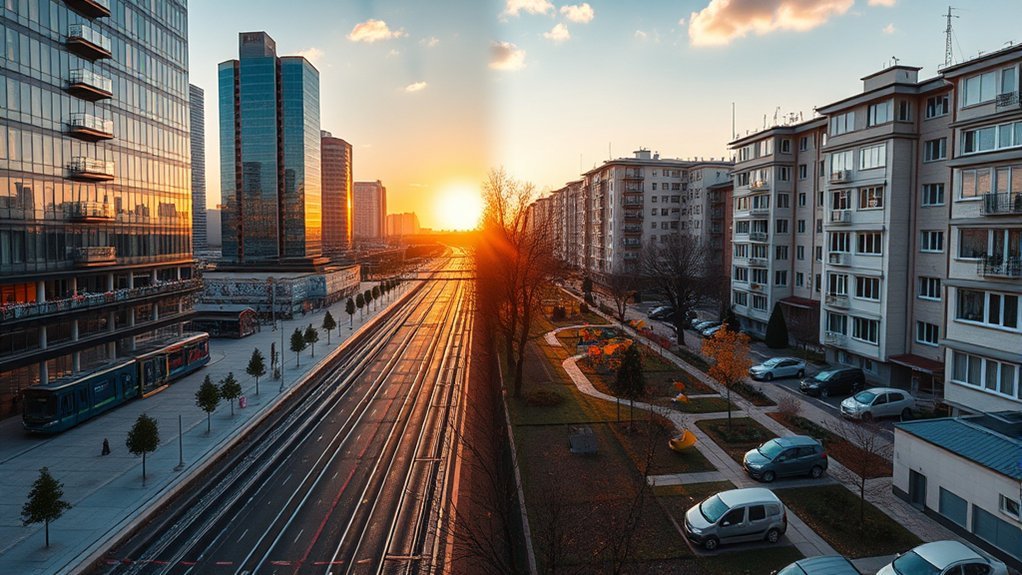You’ll find living in Belarus relatively affordable: a single person typically needs about 2,757 BYN monthly, while couples and families average roughly 4,000 BYN and 5,960 BYN respectively. Rent is the biggest variable — a one‑bedroom in Minsk city center runs about 1,273 BYN versus 807 BYN outside. Utilities, transport and food are modest; utilities for a 915 sq ft apartment average ~179 BYN. Keep reading for a breakdown of housing, everyday costs and banking.
Overview of Living Costs and Key Indices in Belarus

Although prices vary between Minsk and smaller towns, Belarus’s overall cost of living remains low by regional standards: the country’s living cost index stood at 26.4 in April 2025.
You’ll see a clear urban-rural split: Minsk drives a higher cost of living with city-center rents around 1,272.86 BYN for a one-bedroom, compared with lower rents elsewhere.
Utilities for a typical 915 sq ft apartment average 179.42 BYN, a measurable fixed expense you’ll account for monthly.
Eating out is affordable: expect ~30.00 BYN for an inexpensive meal and ~100.00 BYN for two at a mid-range restaurant.
Local transport is cheap, with monthly passes at 48.04 BYN and single tickets at 0.85 BYN, so mobility costs stay modest.
These indices let you model scenarios quickly; plug rent, utilities, food, and transport into your projections to quantify how much that higher cost of living in Minsk will add to your personal budget.
Typical Monthly Budget: Single, Couple, and Family Estimates

One practical way to budget is to start with benchmark estimates: a single person typically needs about 2,757 BYN per month, a couple around 4,000 BYN, and a family of four roughly 5,960 BYN.
Use these anchors to allocate living expenses across categories and test trade-offs. For a single, the benchmark covers food, transport, utilities (about 179.42 BYN), and discretionary spending; you can infer housing consumes the largest share but specifics vary.
For a couple, the 4,000 BYN median assumes shared costs and modest increases in food and transport; per-person costs drop due to economies of scale.
For a family of four, 5,960 BYN factors in higher food, childcare, schooling extras and larger utilities.
Compare these totals to known itemized costs (e.g., 1-bedroom city rent ~1,272.86 BYN, 3-bedroom ~2,210.37 BYN) to model scenarios.
Adjust your plan by shifting percent allocations to reflect priorities and local price changes.
Housing and Rent: City Center Vs Suburbs

Having set monthly benchmarks, you should next examine how housing location reshapes those totals: a one‑bedroom in a city center averages 1,272.86 BYN versus 806.64 BYN outside, and a three‑bedroom averages 2,210.37 BYN downtown compared with 1,409.98 BYN in the suburbs.
When you compare rent figures, urban premiums are clear: one‑bedroom city center rent is roughly 58% higher than suburban, and three‑bedroom downtown costs about 57% more.
If you consider buying, city center prices around 487.48 BYN per square foot further signal elevated urban capital costs. Major cities consistently push housing and rent above smaller locales, so your choice of city matters as much as neighborhood.
For short‑term planning, note cheap one‑bedroom benchmarks: about $281 downtown vs $184 outside — useful cross‑checks against BYN figures.
Use these deltas to model scenarios (single, couple, family) and to prioritize trade‑offs between space, commute, and monthly outlay.
Everyday Expenses: Food, Transport, Utilities, and Internet

Because everyday costs quickly add up, you should budget precisely for food, transport, utilities, and connectivity when planning monthly expenses in Belarus. You’ll find meals range from 30.00 BYN at inexpensive restaurants to about 100.00 BYN for two at mid-range places, so eating out habitually raises your monthly outlay. Public transport is cheap: single rides cost ~0.85 BYN, while a monthly pass is ~48.04 BYN, useful if you commute daily. Basic utilities for a 915 sq ft apartment average 179.42 BYN/month, a significant fixed cost. Internet at 60 Mbps+ averages 34.78 BYN (26–45 BYN), and a mobile plan with 10GB+ costs ~25.17 BYN, keeping connectivity affordable.
| Category | Typical Cost | Notes |
|---|---|---|
| Inexpensive meal | 30.00 BYN | Per person |
| Mid-range meal for two | 100.00 BYN | Restaurant dining |
| Monthly transport pass | 48.04 BYN | Commuter rate |
| Utilities (915 sq ft) | 179.42 BYN | Electricity/heating/water |
| Internet | 34.78 BYN | 26–45 BYN range |
| Mobile plan | 25.17 BYN | 10GB+ data |
Money, Banking, and Useful Services for Expats

After budgeting for food, transport, utilities and connectivity, you’ll also need to plan how to manage money in Belarus — from everyday payments to saving and international transfers.
With an average monthly salary after tax of about $597, you’ll need to align banking choices to that income level. Cash remains common, but cards are widely accepted; compare local bank fees versus multi-currency services.
A mobile plan with 10GB+ data costs ~25.17 BYN and internet at 60 Mbps starts near 34.78 BYN, both important for remote work and online banking.
Basic utilities for a 915 sq ft apartment average 179.42 BYN, so include that in cashflow forecasts. For international transfers and low-cost spending abroad, use providers like Wise, which lets you hold 40+ currencies and keeps transaction fees predictable.
Open a local account for salary and recurring payments, retain an international card for savings and transfers, and monitor exchange and fee data to optimize monthly budgeting.
Frequently Asked Questions
Is It Cheap to Live in Belarus?
Yes — you’ll find Belarus cheap: Cost Comparison shows average living around $571/month, rent and utilities especially lower, and family versus single budgets reflect substantial savings, so you’ll benefit from generally low everyday expenses.
How Much Is Rent in Belarus per Month?
You’ll pay roughly 1,273 BYN/month for a 1‑bed in city center and about 807 BYN outside; 3‑beds run ~2,210 BYN (center) and ~1,410 BYN outside. Rental Trends show wide ranges reflecting location and size.
What Is the Average Salary in Belarus in USD?
You’ll see an average salary of about $597 USD monthly, which, in Salary Comparison terms,’s roughly half the global norm; you’ll analyze modest purchasing power, low cost base, and GDP per capita near $8,317.
Can Foreigners Live in Belarus?
Yes — you can live in Belarus, but you’ll need appropriate Visa Requirements and a residence permit, typically via work, study, or family reunification; prepare documentation proving job offers or sufficient funds, and expect limited English availability.
Conclusion
By now you’ve seen the numbers—rent, food, utilities, transport—line up like columns in a spreadsheet. You’ll find Belarus offers lower costs than many European countries, with city-center rents and imported goods driving the biggest variances. Plan a clear monthly budget for your household type, factor in occasional price swings and banking fees, and use local services to cut costs. With data as your compass, you’ll navigate living here with predictable, measurable confidence.


